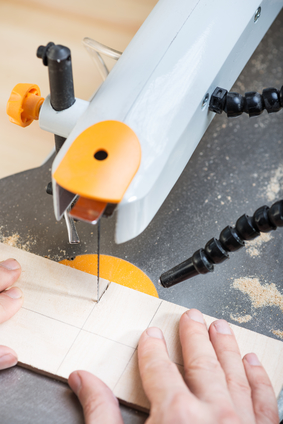The scroll saw is an invaluable tool for woodworkers. It makes detailed crafts and crisp fretwork in a way that no other machine can. You might have already learned the basics on how to use a scroll saw such as turning it on, setting it on the bench and how to start cutting. However, there is so much more important information you need to have at your fingertips that might not be present in the saw’s manual. Here are some scroll saw tips and tricks that will make your projects easier, more fun and more successful.
1. Lighting
It will be difficult for you to get a clean cut when using a scroll saw if you can’t see the pattern line properly. You may also experience a perception problem whereby the black blade and the black line visually merge, making it hard for you to tell the exact position of the blade along the line. It is therefore advisable to purchase lights that can be mounted onto the scroll saw. Alternatively, you can place a lamp next to the saw in such a manner that the blade casts a right-angle shadow on the workpiece. The point of the angle formed by the blade and its shadow will make a good visual reference. For more precision, you can use a magnifier.
2. Blade tension
Blade tension should not be too much or too little. Blades will often break in both cases. Set the tension at that point where you hear a ping when you pluck the blade. At this point it should flex no more than 1/8″ from side to side. If the blade breaks right after you start using it, the tension may be too much. If it wanders, the tension may be too little.
3. Blade retrieval
For you to be an expert scrollsawer, one of the things you’ll need to learn is how to minimize time wastage when changing blades. Most blades become dull or break after about half an hour. You’ll therefore need easy access to an extra supply of blades. One tip you can follow for quick retrieval of blades is to place them on a magnetic strip. The strip should then be attached to the scroll saw stand. Alternatively, you can adhere about 18″ strip of hook-and-loop tape to the side of the saw with epoxy. Next, press containers in which you’ll store the blades against the strip.
4. Warping
Plywood, especially thin plywood, runs the risk of warping. You can prevent it from warping by storing it in a dry, flat surface and placing a heavy piece of wood on top of it. However, this does not imply that you should get rid of warped plywood and go purchase new wood. Dampen the surface of the warped wood and then place it on a flat surface. Place a heavy piece of wood on top of it and leave it for a week or so. Most of the times, a pattern cut out from warped wood straightens out when assembled with other pieces into a project.
5. Successful drill pressing
If drilling a hole through a thin piece of wood, you can prevent splitting by placing a scrap piece below your workpiece. If you are drilling through thick wood, you should drill down till that point where you just break through the bottom surface. Stop drilling the wood, turn it over so that the bottom surface is now facing upwards and finish drilling from this side.
6. Keeping stacked parts together
When sawing several identical parts, they should be stacked together and joined using cyanoacrylate glue. The stack will be held firmly by the glue and the project will fall out effortlessly when you’re done with sawing. Make sure you use the glue in moderation, otherwise it may spread to parts that were to be separated after cutting. Clear packing tape can also be used in place of glue. Tape around the stack to hold the pieces in place.
7. Check the teeth
Before you start the saw, always check the direction of the teeth. Make sure they are to the front of the saw and are pointing down. A blade installed backwards will not cut wood. If it is installed upside down, it will pick wood off the table and slap it back down again. Smaller blades can sometimes rotate while you are tensioning the blade, so be sure to verify the blade is pointing in the right direction.
8. Preventing burning
Put clear packaging tape on top of your hardwood pattern to prevent it from burning. It prevents sawdust from accumulating beneath it and lubricates the blade. When using thicker and harder material set the saw at a higher speed and conversely a lower speed for softer and thinner woods.
9. Scrolling position
You can operate a scroll saw while standing or sitting. If you are an amateur, it is advisable to always stand in front of the saw so as to easily feed the work into the blade and operate the saw without much effort. Whether sitting or standing, make sure you are always comfortable. Scrollsawing can go on for hours and in the process, fatigue and stiff neck and shoulders can creep in. If you saw while sitting, a swivel chair can come in handy because you can raise it higher and tilt the scroll saw by tipping its back with a piece of wood so that it sits at an angle of about 10 degrees. You’ll be able to work comfortably without leaning over or straining your joints and muscles. Whenever possible, use a Pedal Foot Switch which allows you to keep both hands on your work for a safer and more exacting experience.
10. Taking care of scroll saw blades
Blades are vulnerable to rust when stored over a long period of time. You can protect them from rust by spraying a thin coat of WD40 or oil on them. Check out our article on scroll saw blade selection here
Final thoughts
Scroll saw techniques require practice and lots of patience. Just relax and allow the blade to do its work according to its capability. The above scroll saw tips and tricks will help you enhance your skills and derive more self-satisfaction from your woodworking projects. For some other great reading material to beef up your scrollsawing skills check out these helpful books.

